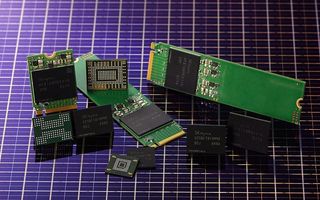Report: Global NAND Flash Revenues See Sharp Decline

A recent DRAMeXchange report revealed that the global NAND flash revenues declined sharply in the first quarter of 2019. The loss of revenues seems to be primarily due to server and smartphone OEMs seeing weakening demand for their products in the fourth quarter of 2018 and then adjusting their inventories downward for NAND flash in the first quarter of this year.
Contract prices for eMMC/UFS, client SSD and enterprise SSD fell by 15~20%, 17~31% and 26~32%, respectively, in Q1 2019. TLC wafer contract prices also fell by 19-28% quarter-on-quarter, even through the decline shrunk compared to the previous quarter.

DRAMeXchange believes that even though smartphones, servers and notebook PCs will see a recovery in the near future, the downward price pressure on NAND flash products will continue.
A recent DRAMeXchange report revealed that the global NAND flash revenues have declined sharply in the first quarter of 2019. The loss of revenues seems to be primarily due to server and smartphone OEMs seeing weakening demand for their products in the fourth quarter of 2018 and then adjusting their inventories downward for NAND flash in the first quarter of this year.
Contract prices for eMMC/UFS, client SSD and enterprise SSD fell by 15~20%, 17~31% and 26~32%, respectively, in Q1 2019. TLC wafer contract prices also fell by 19-28% quarter-on-quarter, even through the decline shrunk compared to the previous quarter.
DRAMeXchange believes that even though smartphones, servers and notebook PCs will see a recovery in the near future, the downward price pressure on NAND flash products will continue.
All NAND Suppliers Lost Revenue, Some More than Others
NAND flash suppliers saw ASPs drop by 20-32%, with Intel and Western Digital being on the low side and SK Hynix on the high side. Intel also saw the lowest decline in revenue (17.3%), followed by Micron, which saw a decline in revenues of 18.5% in Q1 2019. At the other end, SK Hynix’ revenues dropped by more than a third (35.5%).
Stay on the Cutting Edge
Join the experts who read Tom's Hardware for the inside track on enthusiast PC tech news — and have for over 25 years. We'll send breaking news and in-depth reviews of CPUs, GPUs, AI, maker hardware and more straight to your inbox.
Samsung, Micron, and Intel all saw bit shipments growth of 5%, 8%, and 10%, respectively. Meanwhile, SK Hynix, Toshiba and Western Digital experienced a decline in bit shipments. Intel, Micron and Toshiba were the only ones that were able to take advantage of the decline in prices to increase their market shares to the detriment of the other NAND flash suppliers.
SSD Price Decline Expected to Continue
Previous DRAMeXchange reports have said that SSD prices will continue to fall for the rest of the year, although the decline may slow down towards the end of the year. Prices are expected to drop under 10 cents per GB.
Capacities are also poised to increase this year, as most of the players will be able to ship higher-density 96-layer NAND products in volume. This should put even more pressure on the prices per GB to fall,
-
AlistairAB We used to expect memory prices to be cut in half every few years. Nothing is wrong with this, since the cost of manufacturing will drop also.Reply
Most Popular


